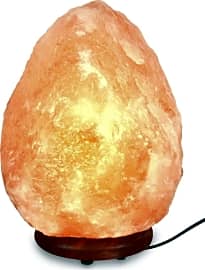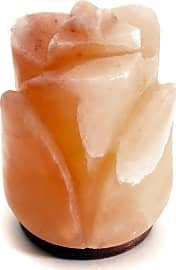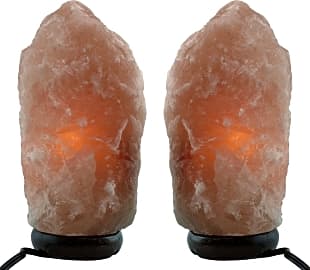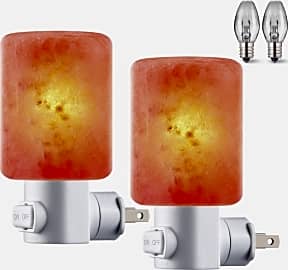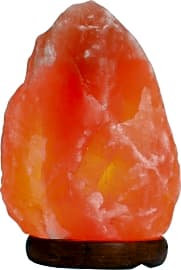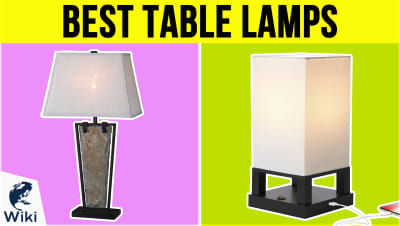The 10 Best Salt Lamps

This wiki has been updated 39 times since it was first published in September of 2015. Create a blissful, relaxing environment in any room with one of these salt lamps. As well as providing a soft, warm, and comforting glow, they are believed to offer a whole host of health and wellness benefits, including soothing allergies, neutralizing odors, relieving stress, and more. Keep them away from your pet, though, as your furry friend could become ill from licking the salt. When users buy our independently chosen editorial choices, we may earn commissions to help fund the Wiki.
Editor's Notes
May 08, 2020:
Himalayan salt lamps are a charming, soothing light source — when used appropriately. These pieces are hygroscopic, which means they can absorb moisture from the air, and in very humid environments, this liquid can drip and leak. Because of this, you'll want to supervise and wipe the wetness away as necessary. This makes a salt lamp more "needy" than many other types of lighting, so be prepared for ongoing care. Also, they're not the best choice in homes with pets. If your animal happens to enjoy salty tastes, it can make itself sick by repeatedly licking the lamp and ingesting too much salt. Pet owners might consider a standard table lamp or mood lamp, instead.
When it comes to top choices, we still think the Crystal Allies Globe and the AMSkart Fire Bowl are worthy of attention. These are striking pieces that give off soothing light; they're perfect for your living room, yoga studio, or meditation den. We added the D'aplomb Authentic, as well, which is carved to resemble a rose. Thanks to this shape, it might make a thoughtful and romantic gift. If you'd prefer a standard "chunk" lamp, there's the Mineralamp Medium or the Airblasters Crystalman. These don't resemble any particular shape, but instead have an earthy, natural look. We've removed the Levoit Kyra Himalayan and the HemingWeigh Natural, however, over concerns about potential problems with their cords. Finally, for something a bit different, we selected the Omonic Rare Gray Queen. It's a grayish-black color, so it's definitely unusual, but it doesn't throw as much light as some. Consider this one if you are fine with a dim glow.
Special Honors
Mindful Souls Blown Glass Whether on or off, the Mindful Souls Blown Glass is just as attractive, as its glass globe boasts swirling colors that accentuate the natural coloring of the salt. It isn't terribly large, so it should fit on most end tables nicely, but it still feels sturdy at just over 5 pounds. mindfulsouls.com
Elemeants Salt Panel The Elemeants Salt Panel is far from ordinary. Instead of a chunk, this model is a large, flat, wall-hanging piece that is sure to be the first thing anyone notices when they walk in the room. Each is made by hand and has a solid hardwood frame, with no unattractive structural elements or hanging light bulbs to detract from its beauty. etsy.com
Hammacher Schlemmer Salt Lamp Diffuser You can blend sight and smell with the Hammacher Schlemmer Salt Lamp Diffuser, although it isn't a must, as the lamp and essential oil diffuser can be operated separately. It runs on three included halogen bulbs and offers five brightness settings, and it even comes with a measuring cup to make filling it a breeze. hammacher.com
What Are HPS Lamps?
Lastly, it can be used as a bath salt for relaxation purposes.
A new trend appearing in homes around the world are Himalayan Pink Salt (HPS) lamps. They are simply lamps made from salt mined near the Himalayan mountains in the neighboring Punjab region of Pakistan. This salt can vary from nearly transparent to a pink, orange, or reddish hue. The warm colors are attributed to impurities of iron and copper found in the salt.
HPS is extremely versatile; while not technically table salt, it's used in cooking at several stages of preparation. It can be heated and placed in an oven at temperatures of 200 degrees Celsius. Himalayan salt can also be used as a brine and as a serving dish. Lastly, it can be used as a bath salt for relaxation purposes.
This salt has recently been recognized for its therapeutic values as a lamp. While many other materials prove to be better illuminators, the salt lamp's opacity gives off a soft, ambient glow that is associated with relaxation or a campfire. For this reason, they are common in yoga studios, massage parlors, and meditation areas.
Considering the recent popularity of these lamps, most consumers might not know what attributes to look for when purchasing. Some key features will include size, color, and functionality. As far as size is concerned, the bigger the better. They can be presented as one large slab of salt, or several pieces compiled together. They come in a variety of sizes from several inches to a few feet.
The color indicates the purity of the salt. Look for darker color to ensure it is 100% Himalayan salt. Cheaper imitations will not be pure nor have the dark rich color. Salt lamps may have a tendency to sweat, or condensate. Salt is hygroscopic, meaning it attracts water and vapor, causing condensation to form. This is beneficial as the vapors encourage bacteria and mold growth. Think of your salt lamp as a germ dream catcher!
Some are non-electric and require a simple wax tea light. While most salt lamps on our list are powered by electricity and require a lightbulb, manual lamps exist that accommodate wax candles.
Illuminate Me
Many claim that salt lamps can work wonders to clean air, reduce allergies, and elevate moods. There is, however, little scientific evidence to fully support these claims. Visually, the orange glow admitted by the lamps is no coincidence. The blue light offered by electronics tend to stimulate the brain, while the warm colors resemble candlelights and campfires which have been shown to aid with sleep and rest.
Negative ions are found in lightening storms, rain, and waterfalls and they are associated with relaxation and the feeling of being refreshed.
Salt lamps are labeled as natural negative ion generators. Negative ions are found in lightening storms, rain, and waterfalls and they are associated with relaxation and the feeling of being refreshed. If these lamps generate negative ions, that means they will mimic the soaking in the sun and lapping waves effect, right? Not exactly. Salt lamps do generate negative ions, however, not a significant amount.
If you want the full effect, spend time in nature, particularly around water. The rationale being that negative ions will cancel out the positive ions, thus cleansing the air. While there is no scientific evidence that salt lamps actually improve air quality, it is a belief that is widely spread and it may be effective only for the placebo effect.
If you truly want to generate a large amount of negative ions, a negative ion generator is a method to produce negative ions in a more effective way than the salt lamps.
A Brief History of Salt Lamps
Salt, also known as NaCl, is an ionic compound of sodium and chloride. It has been a commodity for thousands of years since humans need salt in their diet to survive. In ancient days, salt reigned supreme: Roman soldiers were paid in salt, or sal in Latin, giving birth to the definition of salary. Salt can preserve food and it created the Salt Roads of commerce since salt was not readily available everywhere in the world.
Forty years ago, the idea to carve out a hunk of salt and place a light inside to warm it would produce negative ions.
Salt can be obtained in two ways, from seawater or from rocks known as rock salt. Rock salt is evaporated seawater from ancient bodies of water. Salzburg in Austria derives its name from the salt mines which are abundant.
The emergence of the salt lamp as therapy was stumbled upon three to four hundred years ago. Salt miners worked in the environment on a daily basis and they became the healthiest people in the village. The fine salt vapor in the air inhaled by the miners aided in congestion and breathing. They then carved out salt mines for themselves and their families and stayed in them for extended periods of time to refresh themselves.
Forty years ago, the idea to carve out a hunk of salt and place a light inside to warm it would produce negative ions. The first lamps were outrageously priced, however, most are now affordable because more people are using these lamps and recognize the benefits.


